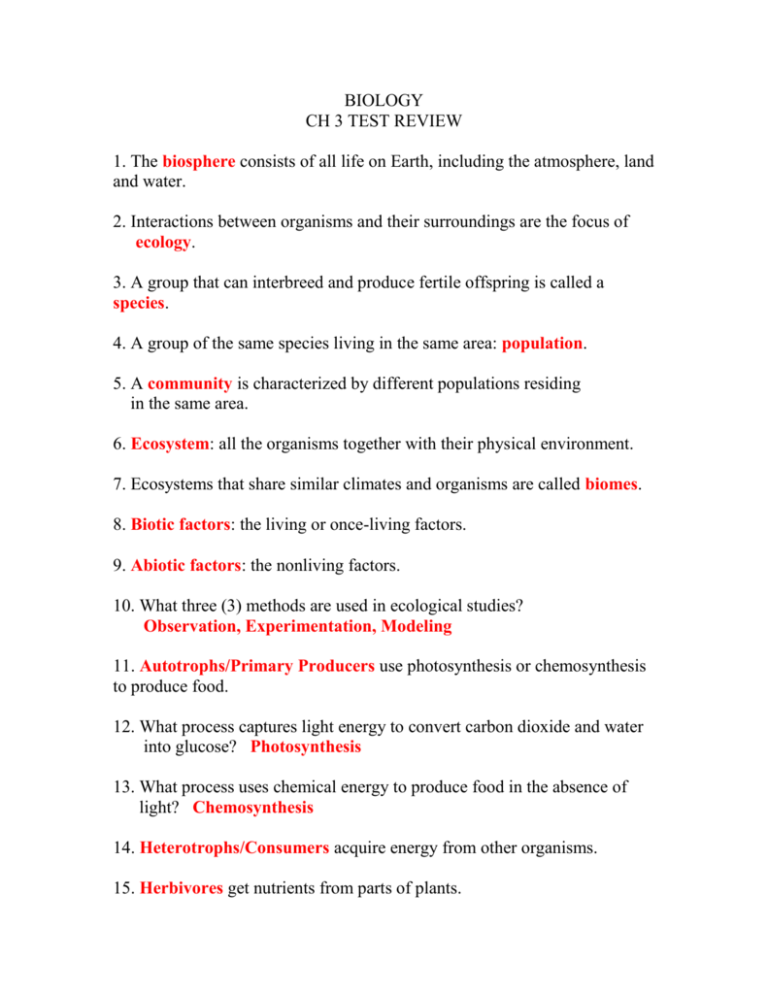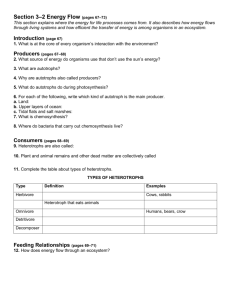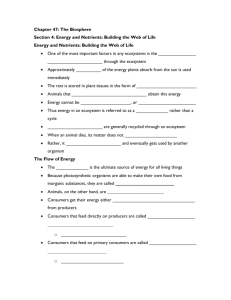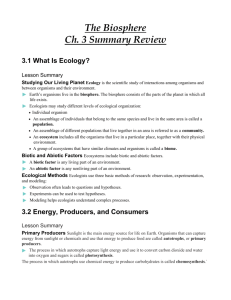BIO CH 3 Test Review
advertisement

BIOLOGY CH 3 TEST REVIEW 1. The biosphere consists of all life on Earth, including the atmosphere, land and water. 2. Interactions between organisms and their surroundings are the focus of ecology. 3. A group that can interbreed and produce fertile offspring is called a species. 4. A group of the same species living in the same area: population. 5. A community is characterized by different populations residing in the same area. 6. Ecosystem: all the organisms together with their physical environment. 7. Ecosystems that share similar climates and organisms are called biomes. 8. Biotic factors: the living or once-living factors. 9. Abiotic factors: the nonliving factors. 10. What three (3) methods are used in ecological studies? Observation, Experimentation, Modeling 11. Autotrophs/Primary Producers use photosynthesis or chemosynthesis to produce food. 12. What process captures light energy to convert carbon dioxide and water into glucose? Photosynthesis 13. What process uses chemical energy to produce food in the absence of light? Chemosynthesis 14. Heterotrophs/Consumers acquire energy from other organisms. 15. Herbivores get nutrients from parts of plants. 16. Meat-eaters are classified as carnivores. 17. Carcasses of dead animals killed by predators are eaten by scavengers. 18. Most humans, and all bears, are omnivores because they eat both plants and animals. 19. Bacteria and mushrooms break down organic matter; they are classified as: decomposers 20. Detritivores feed on detritus particles. Label each of the following as a producer, consumer, or decomposer 21. Mushroom - decomposer 22. Apple tree - producer 23. Squirrel. - consumer 24. A series of steps in which organisms transfer energy by eating and being eaten: food chain. 25. A network of feeding interactions is called a food web. 26. Phytoplankton are a type of plankton and are the primary producers in aquatic biomes. 27. Zooplankton are a type of plankton that feed on phytoplankton. 28. Each step in a food chain or food web is called a trophic level. 29. Name the three different types of ecological pyramids. energy, biomass, numbers 30. Total amount of living tissue in a trophic level: biomass. 31. Elements are recycled in the biosphere by biogeochemical cycles. 32. Nutrients: chemicals that sustain life. 33. Bacteria convert nitrogen gas into ammonia by way of nitrogen fixation. 34. Other bacteria convert nitrates into nitrogen gas in a process called denitrification. 35. A nutrient that limits productivity in an ecosystem: limiting nutrient. Complete the energy pyramid by writing how much energy is available to first-, second-, and third-level consumers by filling in the blanks: 36. 10% is available to first-level consumers. 37. 1% is available to second-level consumers. 38. 0.1% is available to third-level consumers. Fill in the Blanks: Name the three nutrient cycles: 39. Carbon 40. Nitrogen 41. Phosphorus 42. A bird stalks, kills, and then eats an insect. Based on its behavior, which pair of ecological terms describes the bird? a. herbivore, decomposer b. producer, heterotroph c. carnivore, consumer d. autotroph, herbivore 43. What animals eat both producers and consumers? a. herbivores c. chemotrophs b. omnivores d. autotrophs 44. A pyramid of biomass illustrates the relative amount of living organic matter available at each trophic level in an ecosystem. 45. A pyramid of numbers shows the relative numbers of individual organisms at the trophic levels in an ecosystem. 46. A pyramid of energy shows the relative amounts of energy available at the trophic levels of a food chain or food web. True or False: 47. Primary consumers always make up the first trophic level in a food web. False 48. Ecological pyramids show the relative amount of energy or matter contained within each trophic level in a given food web. True 49. On average, about 50 percent of the energy available within one trophic level is transferred to the next trophic level. False 50. The more levels that exist between a producer and a given consumer, the larger the percentage of the original energy from producers is available to that consumer. False











